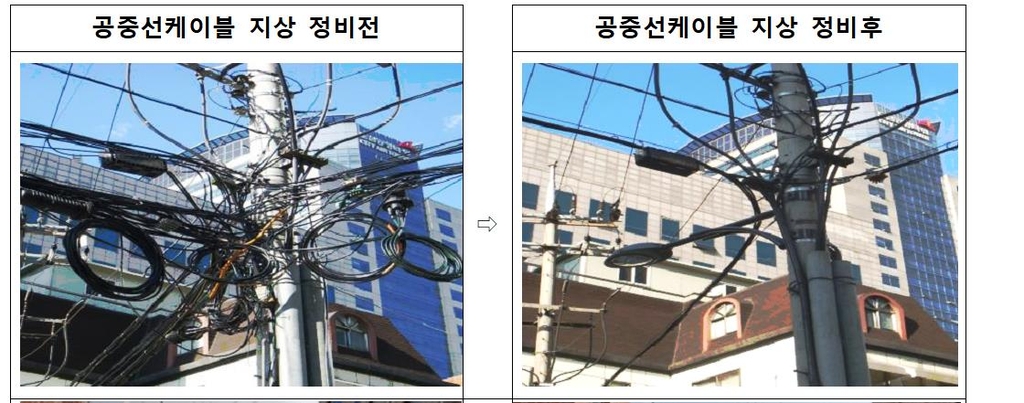Priority maintenance of civil safety risk areas, traditional markets, and special tourist zones
(Seoul = Yonhap News) Reporter Jeong Yoon-joo = The government organizes aerial cables such as wires and communication lines that are complicatedly tangled like spider webs.
The Ministry of Science and ICT announced on the 2nd that it has confirmed the ‘2nd mid- to long-term comprehensive plan for maintenance of aerial cables’.
The Ministry of Science and ICT, along with local governments, KEPCO, and broadcasting and telecommunications companies, will invest 2.85 trillion won in this project over five years. It will spend 1.4 trillion won for the aerial cable ground maintenance project, and 1.4 trillion won for the underground construction project that bury wires in the ground.

[과기정통부 제공. 재판매 및 DB 금지]
This project will be implemented for the second time since over 400,000 main areas and 1,700 areas in Jeonju, which are the poles for tying the electric wires, were reorganized in 2016-2020.
This time, the areas at risk of citizen safety and the traditional markets and residential areas will be reorganized first.
The Ministry of Science and ICT has selected 27 local governments to implement the maintenance project based on the number of residential households and the number of old houses.
The Ministry of Science and ICT plans to evaluate the maintenance plans of 27 local governments, including infrastructure maintenance support and underground expansion plans, and divide them into upper, middle, and lower levels. 30% of the maintenance amount in the area evaluated as’lower’ is redistributed to the area evaluated as’higher’. In other words, an area evaluated as a’top’ area will be able to maintain more household aerial cables.

[과기정통부 제공. 재판매 및 DB 금지]
In the underground project, a budget of 1 trillion won (400 billion won in national expenses and 600 billion won in local expenses) will be invested in connection with the Green New Deal.
For student safety, it also contains the content of promoting the undergroundization of the school zone first.
In addition to the two demonstration areas such as Seoul and Busan, three metropolitan cities such as Daejeon, Daegu, and Gwangju also apply the underground buried mini-trenching method to underground aerial cables.
The mini trenching method can reduce cost by burying wave electric lines or communication lines with the minimum width (30 cm or less) and depth (60 cm or more) of the road.
Wired cables are removed in the relay section between buildings and buildings, and between buildings and Jeonju, and a network-based enhancement pilot project that transmits and receives data through wireless transmission and reception is also promoted.
Second Vice Minister of Science and Technology Jang Seok-young, chairman of the Public Cable Maintenance Council, said, “We will maintain aerial cables to threaten citizens’ safety and improve the city’s aesthetics, and create a street environment by first investing in traditional markets, areas with old houses, and shopping malls.” said.

[과기정통부 제공. 재판매 및 DB 금지]
Unauthorized reproduction-redistribution prohibited>
2021/02/02 12:00 sent
